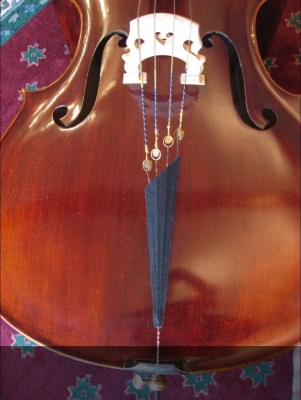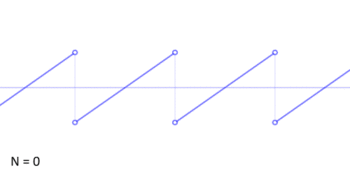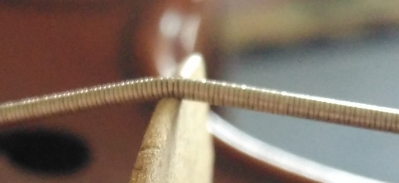Welcome to our forum. A Message To Our New and Prospective Members . Check out our Forum Rules. Lets keep this forum an enjoyable place to visit.
 Topic RSS
Topic RSS



 (1 votes)
(1 votes) 










A "partial take" on the Beach Boys Golden Oldie "Sloop John B". Played primarily for testing the sound and setup of octave strings on my Fiddlerman Concert violin. I may be making some adjustments to the bridge grooves to improve the overall sound - at the moment, the bridge slots have not been deepened, so the fatter octave strings are sitting "high" on the bridge.... we'll see - it's all an experiment!
I seriously recommend not copying my mistakes. D'oh -
Please make your own, different mistakes, and help us all learn :-)
Honorary tenured advisor
Regulars











Thanks @MoonShadows 
Octave strings are a full octave down from "normal" strings - instead of G3, D4, A4, E5 the stings are tuned G2, D3, A3, E4 - these are D'Addario Helicore Octaves-
http://www.orchestral.daddario.....um_Tension
Apart from the "missing" low C2, the remaining G2, D3, A3 are in the normal cello range - although the overall tonal quality will never sound anything like a cello !
Just a lot of fun, and gives a different / another sound canvas to play with !
I seriously recommend not copying my mistakes. D'oh -
Please make your own, different mistakes, and help us all learn :-)
Regulars
 Offline
Offline






Regulars
 Offline
Offline


@BillyG Nice sound Bill and really nice playing.
That fiddle seems to work good with the octave strings. In this recording it comes close to sounding like a cello 
Is the reverb all natural from the room or did you add some? I've been thinking of adding some to my recordings through VideoPad, but have been doing most of my recordings with Debut because of it simplicity.
Again, great job.
Bob in Lone Oak, Texas
Honorary tenured advisor
Regulars











GregW said
@BillyG sounding good! Like the acoustics. Good to know its not affecting the bridge.. Your making me want to give these a go.
Bob said
@BillyG Nice sound Bill and really nice playing.That fiddle seems to work good with the octave strings. In this recording it comes close to sounding like a cello

Is the reverb all natural from the room or did you add some? I've been thinking of adding some to my recordings through VideoPad, but have been doing most of my recordings with Debut because of it simplicity.
Again, great job.

@ABitRusty - no it's not affecting the bridge in any way at all - although - the BRIDGE may be affecting the STRINGS. Strictly, I should (and I intend to) widen the bridge grooves slightly to accommodate the thicker octave strings - there is a chance with the normal groove that it may pinch the string, possibly leading to damage (of the winding). I have intentionally taken the short-term risk of not yet doing it, just to see/hear the difference once they are properly set. And strictly (although I'm not going to do it) the nut slots should be widened/deepened as well - BUT that brings other issues - I can carve a new bridge to swap between normal and octave strings - but I really do not want to mess with the nut - if it goes wrong, re-fitting normal strings could well end up with them being too close to the neck...... What I need is yet another fiddle, dedicated to the octaves I guess Hahahahaha
@Bob - I added some reverb in an attempt to move the overall sound somewhere towards that from a "larger bodied instrument" ( LOLOL ) so you're not really hearing the true sound. I too use VideoPad for recording, but what I then do is detach the audio, take it in to Audacity as a .wav file, process it there, save it, then import the result back into VideoPad - it also give an opportunity to use Audacity's noise-reduction tool which I find pretty good.
I seriously recommend not copying my mistakes. D'oh -
Please make your own, different mistakes, and help us all learn :-)
Regulars
 Offline
Offline















 Thank you @Mark - yes it is an interesting tone.
Thank you @Mark - yes it is an interesting tone.
The strings - probably due to their mass - take a bit of "work" compared to normal string to get the bow hair to properly engage with the strings - and short little 16th's etc can be"difficult" to get them to sound properly (like the bow is off the string, or on to the next note, before it has had time to react).
I'm considering trying a viola bow with its extra stiffness and weight - I'll have to find a viola player first though and sweet-talk them into lending me a bow for a few days ! Hahahaha
I seriously recommend not copying my mistakes. D'oh -
Please make your own, different mistakes, and help us all learn :-)
Regulars
 Offline
Offline




@billyG Very nice! It definitely takes more work with big fat strings. If you find a viola bow, I will be interested to hear the difference. Watching you, you looked like you had a light bow hand, like when you play your regular fiddle. In cello, I use the weight of my arm to put the pressure on, you could try that too.











Thank you Karen @intrepidgirl - yes indeed, well observed and a very good point - and I am "caught in between" trying to load the bow pressure by wrist action (although it may not be obvious), and just play "normally". I hadn't specifically thought about *intentionally* using increased arm-weight - although - in my experiments with these strings - I kind of suspect I have been there and they they just "crunch" with the extra weight - but read on....
At the moment - there are definitely still other issues, which I have referred to either here or elsewhere on our FB pages - it's that "kind of whistle" that sometimes occurs - particularly on the G2 and D3 stopped strings - and - (again apologies if I said this already in the thread here - I get the impression that the string goes into a torsional vibration mode - just like what happens with a "whistling E" on a normally strung violin). I really need to properly seat the strings in the bridge - they are currently sitting on normally cut bridge grooves - i.e. sitting too high on the bridge itself, which could account for a lot.....
I had intended to file out the slots yesterday - but the weather has been too good not to get outside and get on with some gardening work...
I'll keep you all updated here - it is a really fun thing to try... (never sound like a real cello, but nonetheless, an interesting little adventure ! )

I seriously recommend not copying my mistakes. D'oh -
Please make your own, different mistakes, and help us all learn :-)











String seating on bridge - bridge groove is unchanged here - still cut for "normal" violin strings - this is a close-up of the G on the bridge - clearly seen that it's sitting too high ( I knew it would be ) - and ( OK, it could be because I *want* to see it but I suspect it's visible ) - if you view the fully expanded image, yes, you can ( I think ) see the winding separation being just marginally wider as the string curves over the bridge....
As I mentioned earlier - I'm not *overly worried* - I know what I'm doing here, and the "risk" I'm taking with potential damage to the string - the strings are currently only properly tensioned when I play the instrument.... so it's only an hour or so at a time....
Oh - BTW this is the G2 ( not the D3 I was talking about, but it is similar ) - clearly it is way too high on the bridge groove.
I'm on the task, weather has just been too good recently not to spend time in the garden (which needs more attention than my octave strings )
I seriously recommend not copying my mistakes. D'oh -
Please make your own, different mistakes, and help us all learn :-)
Regulars
 Offline
Offline

@BillyG and others. A cautionary note regard the bridge. I would think that the lower tension of the large strings would require a larger amount of clearance between the string and the fingerboard than “normal” strings. Increasing string notch on the existing bridge may well cause buzz.
I just purchased a 16-3/4 Tertis style viola that I bet would sound fantastic with octave strings, but I would likely require head muffs to play the “Rex.” I would play it with a cello bow.
Is there a delay between bow initiation and sound? If so, a marvinusa type of ultra low mass tail stock may speed up the process.

Success is the progressive realisation of a worthy ideal. —Earl Nightingale.











@Irv - yes, thank you for the feedback, appreciated.
Indeed, the G2 particularly, has a HUGE lateral vibration under "enthusiastic" playing :), and at the moment (original bridge) doesn't actually buzz on the neck - but - I sure take your point, especially once the grooves are deepened.
Yes, indeed, there is a distinct "delay" before the bow hair properly engages with the string (I expect that to be improved with the corrected string seating, to some extent)
I had never actually considered a low mass tail stock - good point !
I'll see just what the groove correction does first - hopefully I'll get away without having to carve a new bridge to raise the strings a tad, and then investigate a lighter tailpiece - thanks again ! 
I seriously recommend not copying my mistakes. D'oh -
Please make your own, different mistakes, and help us all learn :-)
Regulars
 Offline
Offline
























starise said
I had no idea there was such a thing as octave strings. Thanks for sharing this.
You're welcome @starise
Looks like a fun thing to get involved in. You could record two parts one low and one higher.
I agree with others who said is has the hint of cello in the tone.
It is a fun thing indeed - and although (as you will have read in the thread) to "get the strings really working properly" there are a number of issues to be aware of.
I love experimenting with these sort of things. And talking of "hint of cello" - here's another fun thing if you haven't seen it in the forum - I have one of my 4/4 fiddles permanently strung as a viola C, G, D, A - and the beauty of THAT one is - with a set of $5 stick-on piezo transducers and a guitar FX box in octave dropper mode - you get the full cello range - here's the demo -
I seriously recommend not copying my mistakes. D'oh -
Please make your own, different mistakes, and help us all learn :-)











Octave strings - ongoing investigations.....
I finally got around to doing this - I was curious to investigate the fiddle's response, in particular to the low strings (the G2 and D3) which are of course below the normally expected frequency-range the (acoustic) fiddle is designed for.
Many will be familiar with the concept of a graphical equalizer on your stereo, even smart phones these days, where you can select specific frequencies to accentuate or attenuate....
Here's a 200Hz to 4kHz equalization curve which cuts out low-ish frequencies (below 200Hz) and higher frequencies (above 4000Hz) and amplifies (lifts) those in between -
Now - by its very construction - a violin has some very specific resonances, and has a response curve which is no way as simple as the example above - but the principle is the same - there are plate and body resonances which effectively respond in sympathy with various notes being played - a typical violin response would not be too dis-similar to this -
As you can see - although a very complex curve - it does exhibit a type of "band-pass" characteristic. What it shows is that frequencies in the range of around 200Hz to around 10KHz are variously affected, some being "lifted" (in volume) more than others. Frequencies outwith that range are highly attenuated, effectively the fiddle itself is not "responding" to them, so they will be present to be heard, but at a significantly lower level.
Fine. Not rocket science.....
But - yeah - although obvious now - it took me a few minutes to explain the following spectrum - taken from playing the octave string G2 on my 4/4 fiddle.
OK - before I post that - for those who don't get the physics involved - let's go back a step.
When a string is bowed, what happens is that the hair grips on a string, then slips back, and the "grip and slip" cycle repeats as the bow is drawn across the string. The grip-and-slip gives rise to the characteristic saw-tooth waveform produced by a bowed instrument - it's kind of like /| /| /| where the "/" is the grip, with the string being forced out of its rest-position, and the "|" is the point at which the hold of the hair (the grip) breaks, and the string slips . We don't need to go into the math behind this - but - any repetitive waveform can be constructed from a sum of the fundamental frequency and a (some) number of its harmonics... here's an animated example of how a saw-tooth wave is constructed building from the fundamental (first harmonic) up to the 50th harmonic - the final waveform getting ever closer to that "perfect" sawtooth....

That is clearly just a mathematical synthesis - in "real life" we don't get perfection like that - the largest difference being the "slip" - which here, is apparently instantaneous (mathematically correct, physically impossible)
OK - so - that was a digression and will let you follow when I talk about the fundamental and its harmonics - so - here's the spectrum analyses of my open G2 octave string - it is not pretty ( nah, it's gorgeous really, tells a lot ) -
Observe that at the far left there are two peaks - the leftmost one is PROBABLY fan noise/vibration (the mic was on the table beside the laptop).
What REALLY got me head-scratching was that the second-left peak, close to the 100Hz marker IS THE FUNDAMENTAL - it is G2 (98Hz)
Now - from the construction of the sawtooth wave, we really expect the fundamental to be the highest amplitude, with its harmonics dropping off
But that's not what I see here. I see the G2 (the fundamental - also known as the first harmonic - of 98Hz, just to left of the 100Hz marker) - but it is REALLY low in amplitude.......
I see G3 (second harmonic in the "saw-tooth waveform additive sine wave component" somewhere to the left of the 200Hz marker - much higher than the first harmonic, but still relatively low)
Things start to "go right" from there on - we have a HUGE G4, then a falling off (the major peaks - ignore the dross at the foot of the spectrum for now) up to the 20th harmonic and beyond ( 20 * 98 = 1960Hz - the highest peak just to the left of the 2000Hz marker)
HOWEVER - once I go to play notes in the normal range a violin is designed for - let's go for the open E ( that's an E4 on octave strings, which would be the E on the D string of a normally strung fiddle ) - we get this truly beautiful spectrum - ( E4 = 330Hz approx - so the first 3 peaks are approx 330, 660, 990... etc )
There is still that low-level "fan noise" down below 100 Hz - but the rest of the spectrum looks fine to me....
SOOOOOO.....
Other observations - playing down on the G and D on the octaves, I can easily feel the vibrations through chin and shoulder. Obviously the energy is going somewhere - but where it is NOT going is into the fiddle itself to be radiated out as sound energy.
Spectrum measurements taken on the A3 and E4 (on normal strings, A3 is on the G3 string and E4 on the D4 string) strings are fine- again - these are now of course within the normal range the violin was designed for....
QUESTION: What happens if I install the octaves on my cheap old EV ? The EV has no resonant body, just a piezo strip under the bridge. Before I bother, I should check (a) the piezo transducer response curve (should be available somewhere) to check it will still work down at 98 Hz - I rather expect it will - and (b) a greater unknown - there's an electronics module built-in to that EV - it is JUST POSSIBLE it has a bandpass filter (like the first image in this post) built in to it to tailor overall response - I won't know until I try.....
Of course, that will mean amping it up - oh, that'll annoy the neighbors half-a-mile-away 
It's been an interesting day....
I seriously recommend not copying my mistakes. D'oh -
Please make your own, different mistakes, and help us all learn :-)
1 Guest(s)


 Log In
Log In Register
Register Home
Home



















